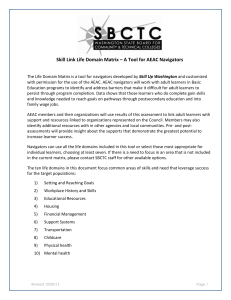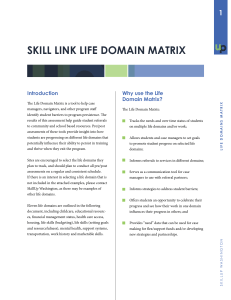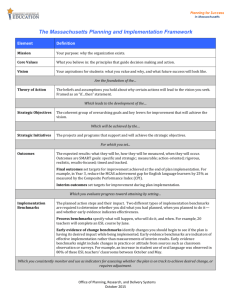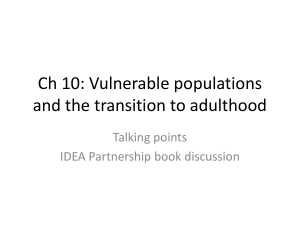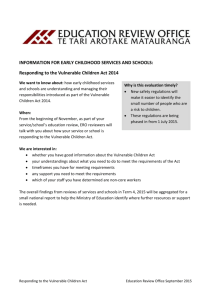Skill Link Life Domain Assessment
advertisement
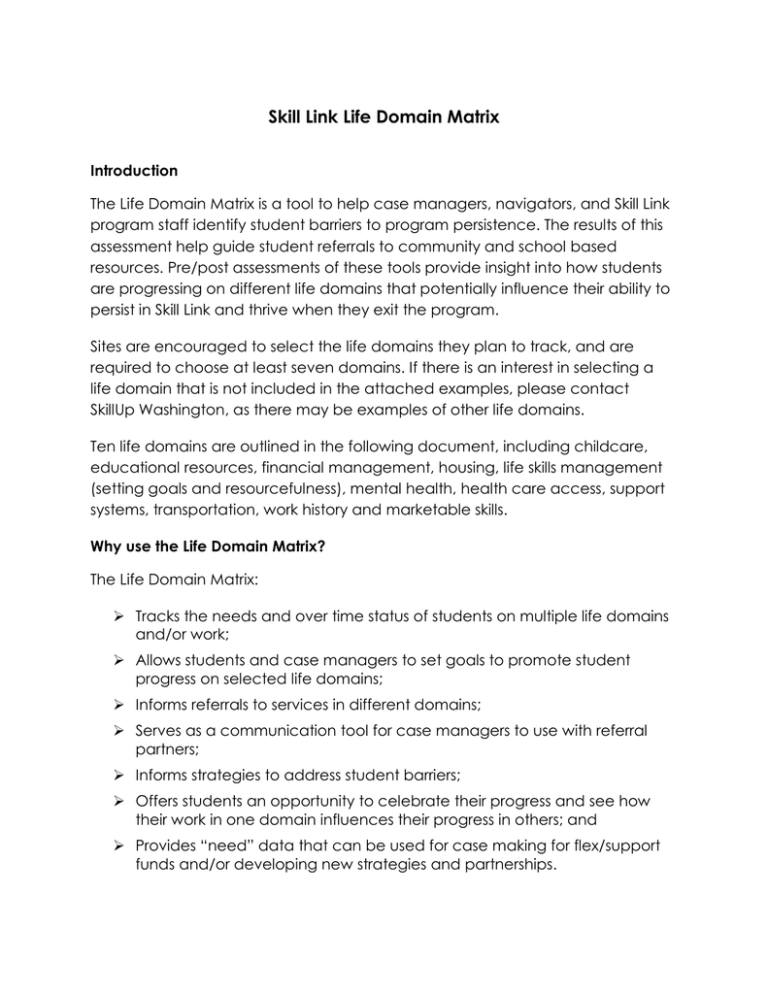
Skill Link Life Domain Matrix Introduction The Life Domain Matrix is a tool to help case managers, navigators, and Skill Link program staff identify student barriers to program persistence. The results of this assessment help guide student referrals to community and school based resources. Pre/post assessments of these tools provide insight into how students are progressing on different life domains that potentially influence their ability to persist in Skill Link and thrive when they exit the program. Sites are encouraged to select the life domains they plan to track, and are required to choose at least seven domains. If there is an interest in selecting a life domain that is not included in the attached examples, please contact SkillUp Washington, as there may be examples of other life domains. Ten life domains are outlined in the following document, including childcare, educational resources, financial management, housing, life skills management (setting goals and resourcefulness), mental health, health care access, support systems, transportation, work history and marketable skills. Why use the Life Domain Matrix? The Life Domain Matrix: Tracks the needs and over time status of students on multiple life domains and/or work; Allows students and case managers to set goals to promote student progress on selected life domains; Informs referrals to services in different domains; Serves as a communication tool for case managers to use with referral partners; Informs strategies to address student barriers; Offers students an opportunity to celebrate their progress and see how their work in one domain influences their progress in others; and Provides “need” data that can be used for case making for flex/support funds and/or developing new strategies and partnerships. How do you use the matrix? At intake, during the program on a quarterly basis, and before a student exits the program the Life Domain matrix should be administered to reflect the overtime status of students in different domains. When using the matrix, staff may want to consider three questions: 1. If a student measures below the “prevention line,” what available interventions do we have to provide the student? 2. Do we have gaps in our partnership’s ability to promote student progress in different domains? If yes, how do we plan to address these gaps? 3. Do the life domain barriers make sense? What, if anything, would we recommend changing in the future? Examples of the Life Domains follow. When a student receives a 1 or 2 rating they are considered in crisis or vulnerable, signaling that they are in immediate need of help. Students who receive higher ratings are identified as safe, stable or thriving. Childcare Dimensions/Benchmarks Scale Elements Thriving (5) Ample resources to support choice of licensed / dependable friends and family options that provide safe settings with adequate supervision Stable (4) Sufficient resources to support limited choice of licensed or dependable friends and family options that provide safe settings with adequate supervision Safe (3) Limited resources to support narrow choice of licensed or dependable friends and family options that provide safe settings with adequate supervision Prevention Line Vulnerable (2) Insufficient resources. Qualifies for subsidized childcare that provides safe settings with adequate supervision. Insufficient resources, barriers exist In-Crisis (1) No access to childcare. Child has minimal supervision. Child is unsupervised and unsafe. Financial Management Skills Dimensions/Benchmarks Scale Elements Thriving (5) Sticks to a budget; has access to checking and savings accounts Stable (4) Uses budgeting skills; has access to checking and savings accounts Safe (3) Knowledge of budgeting skills; has access to checking account Prevention Line Vulnerable (2) No or limited budgeting skills; reliant on predatory banking institutions In-Crisis (1) No budgeting skills or knowledge; no access to banking institutions Health Care Access Dimensions/Benchmarks Scale Elements Thriving (5) All family members have broad access to medical/dental services; no member of household requires treatment and/or current insurance provides full coverage for required treatment and follow-up care; all family members have choice of providers for both medical and dental services. Stable (4) All family members have adequate access to medical/dental services; no member of household requires treatment and/or current insurance provides full coverage for required treatment and follow-up care; some family members have choice of providers for either medical and/or dental services Safe (3) All family members have partial/limited access to medical/dental services; current insurance provides full coverage for required treatment; adequate coverage but restricted in choice of provider Prevention Line Health Care Access Dimensions/Benchmarks Scale Elements Vulnerable (2) Medical benefits available but not accessed; requires medical/dental treatment but coverage does not fully cover; relies upon urgent care centers (not emergency departments) for primary care; have subsidized health insurance but is inadequate for regular exams/check-ups In-Crisis (1) Requires immediate medical/dental treatment with no means to pay; relies upon emergency department as primary source of medical/dental care; not able to pay for medical/dental treatment and not eligible for benefits Housing Dimensions/Benchmarks Scale Elements Thriving (5) Living in unsubsidized housing Stable (4) Living in subsidized housing for longer than the next twelve months Safe (3) Living in subsidized housing sustainable for at least the next twelve months Prevention Line Vulnerable (2) Living in substandard housing; transitional/time limited housing; subsidized housing at risk of losing due to noncompliance with program rules In-Crisis (1) Living in emergency shelter, the street, or other place not meant for human habitation; served with eviction notice; at risk of losing housing within two weeks and have no other place to go Transportation Dimensions/Benchmarks Scale Elements Thriving (5) Always has transportation needs met through public transportation, a car, or a regular ride Stable (4) Has most transportation needs met through public transportation, a car, or a regular ride Safe (3) Has some transportation needs met through public transportation, a car, or a regular ride Prevention Line Vulnerable (2) Rarely has transportation needs met through public transportation, a car, or a regular ride In-Crisis (1) Does not have transportation needs met and has no available public transportation, a car or a regular ride Work History and Marketable Skills Dimensions/Benchmarks Scale Elements Thriving (5) Work history of a year or longer; demonstrated significant marketable skills Stable (4) Work history of six months to a year; demonstrated some marketable skills Safe (3) Limited but consistent work history; possesses some marketable skills Prevention Line Vulnerable (2) Limited and/or inconsistent work history; limited marketable skills In-Crisis (1) No work history and/or negative work history; no marketable job skills Educational Resources Dimensions/Benchmarks Scale Elements Thriving (5) Always able to independently pursue tuition assistance or other college resource options Stable (4) Pursues tuition assistance or other college resource options most of the time Safe (3) Knows where to turn for tuition assistance or other college resources; needs help to pursue resources Prevention Line Vulnerable (2) Has very limited knowledge of tuition assistance or other college resources; can identify areas of assistance but needs help to follow through In-Crisis (1) Has no knowledge of tuition assistance or other college resources Life Skills (Setting Goals and Resourcefulness) Dimensions/Benchmarks Scale Elements Thriving (5) Always able to set goals and be resourceful Stable (4) Frequently able to set goals and be resourceful Safe (3) Usually able to set goals and be resourceful Prevention Line Vulnerable (2) Understands how to but seldom sets goals or is resourceful In-Crisis (1) Has not learned how to set goals and be resourceful Mental Health Dimensions/Benchmarks Scale Elements Thriving (5) No problems in school, work, social settings Stable (4) No or minimal problems in school, work, or social settings Safe (3) Mild to occasional problems with school, work, or social settings Prevention Line Vulnerable (2) Has great difficulty caring for self or others; significant problems with school, work, or social settings In-Crisis (1) Cannot care for self or family; at clear risk of harm to self or others Support System Dimensions/Benchmarks Scale Elements Thriving (5) Is able to give support as well as receive support; always has support Stable (4) Has a healthy support system most of the time Safe (3) Has a healthy support system only in times of crisis Prevention Line Vulnerable (2) Has a healthy support system but is unreliable; has a support system but it is unhealthy and limited In-Crisis (1) Does not have a support system
